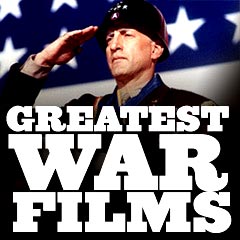
|
Greatest War Movies 1940s-2 |
| Film Title/Year/Director, War-time Setting and Brief Description | |||||
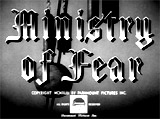
|
Ministry of Fear (1944)
This noirish war film and mystery thriller from Fritz Lang about deception and intrigue was adapted from a Graham Greene novel of the same name. The film was infused with an atmosphere of dread and fear. It told about Stephen Neale (Ray Milland) who was recently released from Lembridge Asylum during wartime England (during the Blitz) - he had been incarcerated for two years for the mercy-killing of his wife. He became unwittingly involved with a Nazi German spy ring (fronted by a charitable organization) when he guessed the weight of a raffle cake - hiding microfilm - at a village fair, the film's MacGuffin. While investigating the enemy network behind everything, he found himself accused by Scotland Yard of an agent's murder, and became warily involved with beautiful German expatriate and Austrian refugee Carla Hilse (Marjorie Reynolds). |
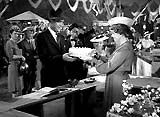 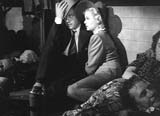
|
|||
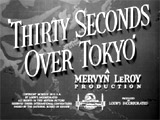
|
Thirty Seconds Over Tokyo
(1944)
Mervyn LeRoy's true-to-life film starred Spencer Tracy as Lieut. Colonel James H. Doolittle, famous for leading the first homeland bombing attack of B-25 bombers (from the USS Hornet aircraft carrier) on Tokyo during WWII, a few months after the attack on Pearl Harbor. It was a secret bombing mission supported by 16 flight crews, who were to drop their bombs and then land in friendly China, although some of the crew members had to ditch their fuel-empty planes and suffered injuries and amputation. The war film, which won an Academy Award for Special Effects (mixing actual footage and stock footage), was based on mission pilot Ted Lawson's 1943 book of the same name. |
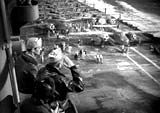
|
|||
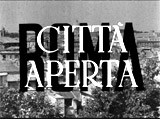
|
Rome, Open City
(1945, It.) (aka Roma, Città Aperta)
Roberto Rossellini's influential, low-budget documentary-like landmark film formally introduced Italian Neo-realism - it was the first film in a Rossellini 'war trilogy' of post-war Neo-realistic films. The gritty and realistic post-war film was set in the underworld of war-time resistance, with the use of on-location cinematography, grainy low-grade black-and-white film stock and untrained actors in improvised scenes. The film followed the plight of fugitive Resistance leader Giorgio Manfredi (Marcello Pagliero), who was eventually caught and tortured to death, after being betrayed by traitorous ex-girlfriend and prostitute Marina Mari (Maria Michi). In another of the shocking, realistic scenes, pregnant widow Pina (Anna Magnani) ran after a military truck hysterically screaming the name of her lithographer fiancee and underground leader Francesco (Francesco Grandjacquet), who was just arrested. She broke away from a soldier molesting her and ran after Francesco, when she was abruptly machine-gunned and killed the morning of her planned wedding day. Witnessing the murder was Pina's ten year-old son Marcello (Vito Annichiarico) and brave Catholic parish priest Don Pietro Pellegrini (Aldo Fabrizi), both involved in the Resistance movement. In the film's conclusion, the priest was apprehended and about to be executed by a hesitant Italian firing squad, when the German officer in charge personally decided to shoot him. |
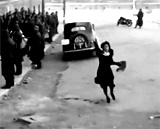 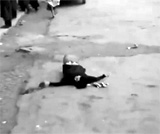 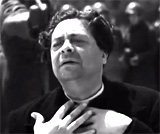
|
|||
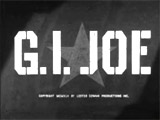
|
The Story of G.I. Joe (1945)
(aka Ernie Pyle's Story of G.I. Joe) William A. Wellman's poignant but unsentimental action-war drama was released just after the German surrender. It was one of the best and most realistic of all WWII combat films. The film included an Oscar-nominated performance by Robert Mitchum as tough Lt./Captain Bill Walker, and featured a number of GIs appearing as extras. It told the story of Company C, 18th Infantry foot-soldiers of the US Army chronicled by Pulitzer Prize-winning journalist and war correspondent Ernest "Ernie" Pyle (portrayed by Burgess Meredith), during miserable campaigns in North Africa and Italy, especially the Battle of Monte Cassino. Pyle was allowed onto trucks traveling to the front for the first time by Lt. Bill Walker, and endured the arduous hardships along with the untested infantrymen. |
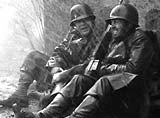
|
|||
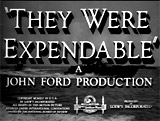
|
They Were Expendable (1945)
Toward the close of the war, director Ford (after making wartime documentaries) based this realistic, old-fashioned, under-rated, inspiring and bleak (black and white) war film upon the historically-true story of the Navy's PT boat squadrons and crews based in the Philippines that were supporting the naval war in the Pacific campaign. The crews of the fast, maneuverable, lightweight plywood (not metal) PT (short for patrol torpedo) boats armed with torpedos, were there during the early years of the war (Dec 1941 - April 1942) and faced the greatly-outnumbered advance of Japanese forces immediately after the bombing of Pearl Harbor. The straight-forward, well-directed, semi-patriotic film, a detailed and authentic-looking action-war drama, was based on William L. White's bestselling 1942 book with the same title. The film's title-card prologue was a quote from General MacArthur, who had to be evacuated from the Philippines (with his famous "I shall return" statement): "Today the guns are silent. A great tragedy has ended. A great victory has been won....I speak for the thousands of silent lips, forever stilled among the jungles and in the deep waters of the Pacific which marked the way." The war film told about two major characters: torpedo boat squadron commander Lt. John Brickley (real-life Congressional Medal of Honor winner John Bulkeley) (Robert Montgomery) and his second-in-command executive officer, PT boat officer/skipper Lt. J.G. "Rusty" Ryan (real-life Robert Kelly) (John Wayne). There was exciting footage of the defense of the Philippines by the highly maneuverable PT boats with gun turrets. A hospitalized Ryan had moments of on-screen romance with nurse Lt. Sandy Davyss (Donna Reed) when he was in sick bay. The end sequence was the airlift evacuation of the last plane (with only 30 seats) of key personnel from the Philippines to Australia, with Brickley in seat # 27 and Ryan in # 28. Readying for take-off, Brickley explained the reason for their evacuation, when asked if there would be any more planes: "Look, son, we're going home to do a job. And that job is to get ready to come back. Check?" The two responded in unison: "Check." The small remaining group on the ground solemnly watched as the plane took off. MacArthur's words: "We Shall Return" came into view (before 'The End' title), as "The Battle Hymn of the Republic" was heard on the soundtrack. |
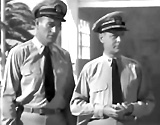 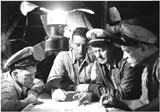 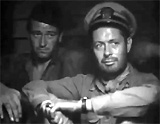 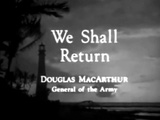
|
|||
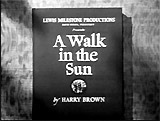
|
A Walk in the Sun (1945)
This was Milestone's second (and middle) film in a war trilogy, composed of All Quiet on the Western Front (1930), and Pork Chop Hill (1959). It is often considered one of the best WWII war-battle films ever made, although it was essentially bloodless. It thoughtfully portrayed the psychological stress felt by the US GIs. Milestone's modest yet starkly realistic, dialogue-filled, unglamorized combat film, based upon the novel by Yank Magazine's Harry Brown, followed an American infantry unit in 1943, led by platoon squad leader Sgt. Bill Tyne (Dana Andrews) that was struggling to survive during a mission. They were making a frontal assault on a fortified, Nazi-occupied farmhouse in Italy, as part of the Allied attack on Anzio. The tension and fear was brilliantly captured on the faces of the terrified soldiers as they took a short, six-mile journey (from the coastal beach at Salerno, moving inland through the Italian countryside) to the farmhouse where they also were on a mission to blow up a bridge. Despite heavy losses and fearful madness, the bridge was destroyed and the platoon triumphantly captured the fortified farmhouse. |
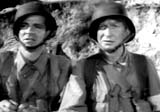
|
|||
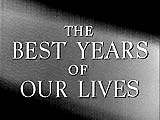
|
The Best Years of Our Lives (1946)
A landmark, classic drama, and Best Picture-winning film - both powerful and provocative with many touching moments in the lives of combat survivors now returned to their former lives (demobilization), with both hopefulness and poignancy. With great acting, story-telling, direction by Wyler, and pacing, as it told about three WWII veterans attempting readjustment to peacetime life and discovering that they had fallen behind. Perhaps the most memorable film about the aftermath of World War II, it unfolded with a number of great plot threads about the homecoming of three servicemen to their small town: Army Sergeant Al Stephenson (Fredric March) who turned to drinking, Air Force major Fred Derry (Dana Andrews) who was rejected by his spouse Marie Derry (Virginia Mayo), and seaman Homer Parrish (Harold Russell) who had lost both arms and agonized over his relationship with his girlfriend Wilma Cameron (Cathy O'Donnell). The homecoming scene of Al Stephenson when his wife Milly (Myrna Loy) sensed his presence, was deeply moving. The compassionate movie portrayed the reality of altered lives, readjustments at work, dislocated marriages and the inability to communicate the experience of war on the front lines or the home front. This was the first picture for Harold Russell, a non-actor and war veteran who was an actual amputee, who won two Oscars for the same role (a unique achievement) - Best Supporting Actor, and a Special Honorary Oscar "For bringing hope and courage to his fellow veterans through his appearance..." In two of the film's memorable scenes, Hoagy Carmichael taught double-amputee Russell to play Chopsticks on the piano, and Russell displayed his vulnerabilities to his fiancee in his bedroom. |
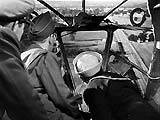 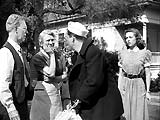 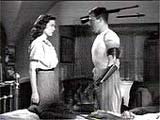
|
|||
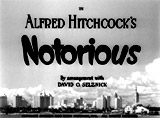
|
Notorious (1946)
The 'master of suspense' created a compelling spy mission interwoven with a romantic love story. The dark, intricate film was thematically concerned with both political (and sexual) betrayal and issues of trust, friendship, and duty embodied in the characters' relationships. Hitchcock told the subtle tale of beautiful but confused and agonized Alicia Huberman (Ingrid Bergman) with a reputation for loose living as a playgirl (she was also the American-born daughter of a convicted Nazi sympathizer). She was reluctantly convinced to infiltrate an evil German cartel by marrying a Rio-based, Nazi enemy leader Alexander Sebastian (Claude Rains), her former rejected suitor, who was living there incognito. A love triangle developed between the three main characters - the Nazi villain, a federal intelligence agent named T.R. Devlin (Cary Grant), and the woman in between - Alicia. In the exciting and nerve-wracking finale - Alicia's rescue scene - guilt-ridden Devlin made an ascent of the stairs to the weakened and sedated Alicia on her deathbed, after she was slowly being poisoned with arsenic-tainted coffee. He carried her down the staircase in full view of the Nazi enemy and out to a car - reportedly to take her to the hospital. He locked the car door on Sebastian, telling him: "No room, Sebastian." In the final moments, Alex received an ominous summons, the last line of dialogue, by one of his sinister, renegade Nazi agent superiors inside the front door: Eric Mathis (Ivan Triesault): "Alex, will you come in, please? I wish to talk to you." |
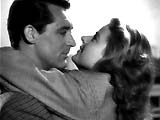 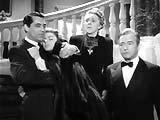 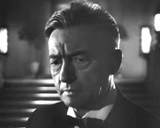 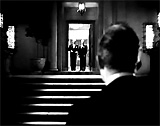
|
|||
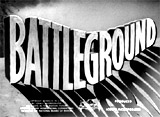
|
Battleground (1949)
Noted as the first significant post-WWII film in the US. It told about a WWII platoon, a group of raw American recruits in the elite 101st Airborne Division ("The Screaming Eagles") trapped at the strategic crossroads of the city of Bastogne in late 1944 during wintry conditions. A solid, ultra-realistic, grim and authentic-looking war drama, it was nominated for six Oscars (including Best Picture), with wins for Best Writing, Story and Screenplay (by Robert Pirosh, a veteran of the Battle of Bastogne) and Best B/W Cinematography. The soldiers were dug in behind the German lines during the German's last-ditch advance at the Battle of the Bulge (the Siege of Bastogne), surrounded and outnumbered and awaiting their fate. The story was told as a character study of the various stressed-out GI comrades and dogfaces from around the country - including their fears, hopes, light-hearted humor and courage. When caught in inclement weather (the "fog of war"), the infantry group was cut off from supplies (reinforcements of food and ammunition) and military intelligence. The star-studded cast included James Whitmore as tough, tobacco-spitting lead Sgt. Kinnie suffering from frostbitten feet, Van Johnson as paratrooper Pfc. Holley, while Ricardo Montalban played the part of Pvt. Johnny Roderigues, a religious Latino from LA, John Hodiak was featured as Jarvess, an enlistee and Kansas newspaper columnist, Marshall Thompson as innocent and idealistic rookie Pvt. Layton - the film's narrator, and George Murphy as Pop Stazak, the oldest member of the platoon. Eventually when the skies cleared, the platoon survived after airplanes dropped parachutes with supplies, and they were relieved by fresh troops. |
 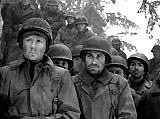
|
|||
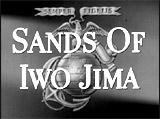
|
Sands of Iwo Jima (1949)
Director Allan Dwan's revisionistic, politically-correct, blatantly-patriotric, historically-inaccurate action-war drama was made after the war by Republic Studios; the film's backdrop was of the training and preparation required of the US Marine recruits before they landed on Iwo Jima in 1945. Specifically, it followed the conflicts that emerged between two individuals in particular - a war of words and values between Sgt. Stryker and PFC Peter Conway. Tough, battle-hardened and harsh Marine Sergeant John M. Stryker (Oscar-nominated John Wayne, with his first Academy Award Best Actor nomination) addressed his combat soldiers in New Zealand in 1943 - a new batch of rebellious greenhorn recruits-troops to fight in the Pacific theatre of the war as a rifle squad. Although he would exhaust the recruits with his rough training methods, the infamous commander was determined to mold them into fighting men. His strict expectations were echoed in his commands to the rifle squad:
The gung-ho Stryker repeatedly used the phrase: "Saddle up!" to get his platoon of soldiers moving. One of Stryker's men was Pfc Peter Conway (John Agar) - the college-educated son of Colonel Sam Conway (Stryker's deceased former commanding officer at Guadalcanal) who was killed 10 months earlier. Conway felt that his commanding officer Stryker was similar to his demanding father, who had shamed him, thought he wasn't tough enough, and had considered him cowardly and inferior. The two often sparred with each other. Five years earlier, the hard-nosed Sgt. Stryker had separated from his wife Mary and now 10 year-old son (who failed to write to him), and had become embittered with life, when his ex-wife took full custody. He began drinking, and often took out his frustrations on the men under his command. That same year during a brutal November 1943 assault, he led his troops in an American offensive in the critical central Pacific region, at the Battle of Tarawa. Ironically, Conway proved his manhood and worth by heroically saving Stryker's life during a difficult landing on the rocky cliffs of Japan's island of Iwo Jima, when Stryker was unexpectedly jumped by a Japanese soldier with a sword. Conway jumped in to defend Stryker by stabbing the enemy to death. Afterwards, the two established a strong friendship and bond. Stryker's forces were eventually responsible for the strategic re-taking of the volcanic Japanese island of Iwo Jima (on top of Mount Suribachi) from the Japanese in February 1945. At first, they suffered heavy casualties, and as they took a break after an assault, Stryker was unexpectedly and randomly killed by a Japanese sniper's bullet from a spider hole. It was an unheroic death. He had paused to relax with a cigarette after having just told fellow Marine Conway: "As a matter of fact, I never felt so good in my life" and was asking: "How about a cigarette?"
As Conway embraced Stryker's dead body, he discovered an undelivered and unfinished letter written by Stryker to explain himself to his son. A dramatic and somber moment involved the reading of an unfinished letter that Stryker was going to send to his son:
The film's last line (accompanied by the singing of The Marines' Hymn) was delivered by Conway (using Stryker's words) - it was heard with the memorable raising of the flag ("There she goes") on Mount Suribachi in February of 1945: "All right! Saddle up! Let's get back in the war!" |
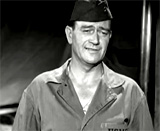 Sgt. Stryker (John Wayne) Addressing His New Recruits 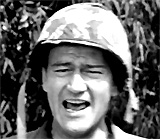 Stryker: "Saddle up!"  Pfc. Peter Conway (John Agar) 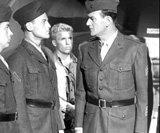 Stryker Again Lecturing His Men 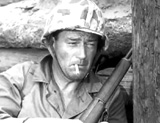 Stryker in the Trenches With His Men at Tarawa 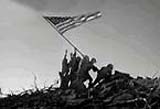 Raising of the Flag on Mt. Suribachi 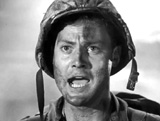 Conway: "All right. Saddle up. Let's get back in the war!" |
|||
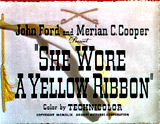
|
She Wore a Yellow Ribbon (1949)
It was noted for Winton C. Hoch's beautiful Oscar-winning color cinematography (the film's sole nomination and win), filmed in his favorite scenic locale - Monument Valley. This was Ford's personal favorite of the so-called 'cavalry trilogy' of films (preceded by Fort Apache (1948) and followed by Rio Grande (1950) which were in black and white). John Ford's autumnal and sentimental western starred John Wayne as a retirement-age cavalry captain named Nathan Brittles, serving at Fort Starke, a one-troop cavalry post, in 1876. In one sunset scene, soon-to-be retired Capt. Brittles sat at the gravestone of his wife Mary Cutting Brittles and spoke to her while he watered the flowers. The Captain's main goal was to prevent a large-scale Native-American Indian uprising with Chief Pony That Talks (Chief John Big Tree) following General Custer's (and the 7th Cavalry) defeat at the Battle of the Little Big Horn. On a dangerous mission and his last patrol, he protectively accompanied two women who were being evacuated for their own safety to an awaiting stagecoach at Sudros Well: post commander Major Allshard's (George O'Brien) wife Abby 'Old Iron Pants' Allshard (Mildred Natwick), and attractive single lady Olivia Dandridge (Joanne Dru) (with a 'yellow ribbon' in her hair signifying she had chosen a beau) - who was being pursued by two lieutenants in the fort, including Lieutenant Flint Cohill (John Agar) and Lieutenant Pennell (Harry Carey, Jr.). During the trip, Captain Brittles learned that warring Indians had destroyed the stage depot, forcing them to return to the fort. On his last day in a farewell scene, Brittles' C troops gave him a silver pocketwatch with the inscription "Lest we forget" that he tearfully and proudly read with his glasses. To avoid a bloody war, even after his retirement, Brittles chose a risky strategy of stampeding the Indians' horses out of their camp at midnight, to force them to return to their reservation on foot. |
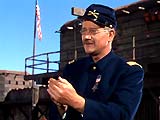 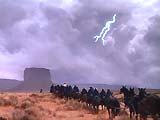
|
|||
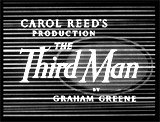
|
The Third Man (1949, UK)
Carol Reed's British visually-stylish film noir thriller - a paranoid story of social, economic, and moral corruption - has been widely acclaimed as an effective suspenser and one of the best films of all-time. It was adapted from Graham Greene's novella written to prepare the film's screenplay, then later published. With a haunting zither musical score and theme from Anton Karas, and innovative b/w camera-work (by Robert Krasker) to accentuate the gloomy, depressed, rotting and sinister atmosphere. Unusually reckless, canted camera angles (one of their earliest uses), and wide-angle lens distortions amidst the atmospheric on-location views of a shadowy Vienna cast a somber mood over the fable of post-war moral ambiguity and ambivalent redemption. The deliberately unsettling, tilted angles reflected the state of the ruined, fractured and dark city - ravaged, crumbling and desperate during the Cold War, and split among the occupying forces. Vienna was also filled with black marketeers, spies, refugees, thieves, and foreign powers seeking control. A pulp Western novelist Holly Martins (Joseph Cotten) arrived in Vienna, totally broke and hoping to find employment. He was forced to assume the role of an amateur sleuth as he looked for old friend Harry Lime (Orson Welles) who had reportedly been killed in Vienna in a car accident days earlier - although there were mysterious circumstances surrounding the incident. He sought to unravel the mystery of the presumed-dead friend with a probing search, and an infatuation with Lime's actress girlfriend Anna Schmidt (Alida Valli). The first appearance of Lime was in a doorway, as a light suddenly illuminated his sardonic smile. He ultimately learned that Lime was a vile, unscrupulous and notorious black-market drug dealer who preyed on the sick with diluted penicillin. The great thriller included the dramatic scene atop a ferris wheel (with the famed "Swiss cuckoo clock" dialogue), a suspenseful manhunt led by Major Calloway (Trevor Howard) into the underground city sewers for Lime - a shadowy, marked man, and the famed ending of Anna's stoic shunning of Martins while remaining loyal to Lime. |
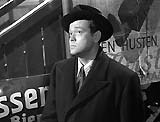
|
|||
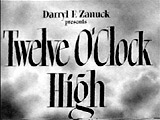
|
Twelve O'Clock High (1949)
A great and realistic war film about leadership - and a superb and enthralling character study emphasizing the stress encountered by various WWII officers who led US forces into combat. Although effective against the German Nazis, the heavy bombing raids in a hot combat zone took a horrendous, self-destructive, emotional and physical toll on fliers and aircraft. The terrifying and dangerous air raids were dramatically photographed in numerous aerial sequences. This timely, tense and compelling film was told in flashback (from the year 1949, looking back to 1942) by middle-aged, introspective American tourist Harvey Stovall (Dean Jagger) who was visiting an abandoned airstrip in England. Years earlier, he had served with the struggling 918th Bomb Group (of the US Eighth Air Force) of B-12 bombers based at Archbury, England in late 1942. He recalled when Brig. Gen. Frank Savage (Gregory Peck), a tough, hard-as-nails, discipline-oriented commander was assigned to the unit. [Note: Peck's character was based on Colonel Frank Armstrong, Jr. whose exploits in whipping into shape the real-life 306th Bombardment Group at Thurleigh Field in England were documented in the 1948 novel of the same name by the film's scriptwriters Sy Bartlett and Beirne Lay, Jr.] Known as a very strict, harsh and by-the-book officer, Savage replaced compassionate, soft-hearted but popular predecessor Colonel Keith Davenport (Gary Merrill) who had been relieved of his duty after resisting to send his men on another near-suicidal, low-altitude daytime mission. At first, the scarred, hard-luck men with low morale resented and detested the personal style of their stern replacement commander who insisted on discipline, and many of them threatened to be transferred. However, they gradually learned to respect him. Over time, Savage began to over-identify with his beleaguered men, and suffered from the same effects that doomed Davenport. In the stressful atmosphere of uncertainty, risk and danger, he began to act erratically, went into shock and had a nervous breakdown during a mission. |
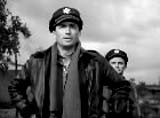 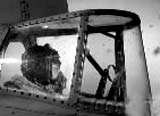
|
|||
(chronological by film title) Introduction | 1900s-1920s | 1930s | 1940s-1 | 1940s-2 | 1950s | 1960s-1 | 1960s-2 | 1970s | 1980s | 1990s | 2000s | 2010s | 2020s |